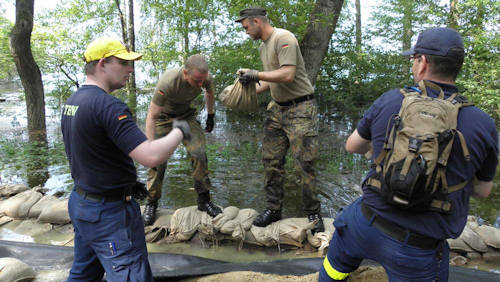Terrifying floods are increasingly common, which in a few hours erase inhabited areas and geographical references. The images of North Rhine-Westphalia and the motorway in the Erftstadt-Blessem stretch, western Germany, are just some of the most dramatic flashes in the hours when the Marien-Hospital is being evicted and there are already over 160 deaths and dozens of missing. The situation of the Steinbach dam at risk of rupture and flooding is also of concern.
The importance of the logistics sector
900 are the first soldiers of the German army who left the barracks in no time aboard amphibious vehicles, trucks, tanks, helicopters and boats to save lives stuck in homes, cars or under rubble. Operations take place without electricity and a crucial role, in these contexts, is played by generators and lighting towers.
The ability of an army to convert quickly to a highly organized advanced civil protection body which, thanks also to a rapid decision-making power, is able to move with ease in complex rescue operations is a common resource in many countries.
Armored vehicles clear the streets

On the Erftstadt-Blessem autobahn, it was a team of Fuchs 1 of Rheinmetall (MAN Military Vehicles) to move in the river of water dragging in a single journey a series of vehicles that partly floated on what was an orderly highway. It is a 6x6 amphibian, Armored Troop Transport Vehicle, which can wade up to 8 km / h driven by its two four-blade propellers. It is designed to carry a total of 12 soldiers and is equipped with several hatches on the roof in addition to the tailgate.
Its conformation allowed the soldiers to follow the clearing work from the openings while the conductor was driving the armored vehicle powered by a Mercedes turbodiesel engine (OM 402A). A 12,8-liter displacement with eight cylinders arranged V and well 320 hp, a tactical integral also capable of a load between 4 and 5 tons, which become 6 for the Fuchs 2. The second series is powered by an 6-liter MTU 11,9V diesel for 456 hp. Both have an automatic transmission with torque converter and a hydraulic retarder given the 17-ton PTT. 7 meters long and 2,5 meters wide, it is designed to steer both on the first and third axles, this to optimize its maneuverability.
Scourged areas, land for crawlers
Tracked troop transport wagons, equipped for the occasion with a front shovel flush with the ground, brought to mind - in the tragedy - the tracked fleet of our little-named Genio Pontieri. The Tanks, or rather the "Panzers", walked the streets of the towns in the province of Düsseldorf, piling up tons of rubble that blocked the streets and did not allow the water to drain. The strength of these vehicles made it possible to remove articulated lorries, lorries, railway wagons and demolish unsafe structures.
 A large contribution was also made by civilians and volunteers who used excavators and bulldozers alongside the military.
A large contribution was also made by civilians and volunteers who used excavators and bulldozers alongside the military.
Trucks, PMA, and command posts
Removing and clearing the rubble is not enough when there is a major disaster, in fact it is necessary to take care of people and look for them even with boats or helicopters. In some areas affected by the storm in North Rhine-Westphalia, the helicopter was the only means capable of bringing immediate relief, while the boats made it possible to approach isolated houses.
In the same way it was the US Army paratroopers who brought first aid to Haiti in 2010: even there the roads no longer existed.
Restoring a telephone or electric line, cutting off the gas or temporarily associating a generator to the outside line, is part of the modus operandi of the rescuers. In record time, a small town of military tents was prepared to house the population, several were equipped as advanced medical posts before the transfer of patients to accessible hospitals.
The box trucks in vegetated livery of the Bundeswehr were used for the evacuation of Oberdrees and Niederdrees as it happened for Swisttale Rheinbach, the localities at the foot of the damaged and unsafe dam.
The coordination of operations? It is attributed toFederal Office for Civil Protection (BBK) in synergy with the military command.

Photo: Bundeswehr












